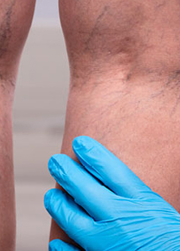
Varicose Vein - What is Varicose Vein? - Overview, Cause, Treatment - Radio - Frequency Ablation
30 Aug 2021Varicose veins are twisted, blue or purple veins that protrude under the skin’s surface. Usually, they don’t result in serious health issues. If veins are painful or bleeding, or if there is swelling, consult a doctor. An individual can decrease symptoms with remedies in the house or have them treated with modestly invasive procedures.
Causes
Varicose veins take place when the walls of veins weaken. As blood pressure in the vein increases, the weakened walls result in the vein enlarging. As the vein expands, the valves in the vein won’t be able to function the way they have to. Slow-moving blood accumulates in the vein, causing the vein to either swell or twist.
The walls of the vein weaken due to:
- Hormones
- Ageing
- Overweight
- Restrictive clothing
- Pressure inside the vein because of standing for a long duration
Symptoms
- An achy or feeling of heaviness in the legs
- Cramping of muscles, inflammation, burning feeling in the lower legs
- Increase in pain after sitting or standing for a longer duration
- Prickling around the veins
- Discoloration of the skin around the varicose vein
Treatment
Surgery
In case the varicose veins are large, a surgical process to remove them might be required. It is typically done under a general anaesthetic. Usually, the patient can be discharged on the same day. If surgery is needed on both legs, they may have to get admitted for one day. Laser treatments are also used to block off smaller veins. Strong discharges of light are applied to the vein, which steadily wanes and disappears.
Ligation and Stripping
Two incisions are done, one near the patient’s groin at the top of the targeted vein, and the other is made further down close to the ankle or knee. The top of the vein is strapped and secured. A wire which is threaded and pulled out through the bottom takes the vein with it. The process does not need hospitalization. Once the surgery is completed, patients would require few weeks to recover before commencing their work.
Radiofrequency Ablation
Radiofrequency ablation is a modestly invasive treatment for varicose veins. Using an ultrasound scan, a small incision is performed near the knee; a catheter is threaded into the vein. The doctor place’s a probe into the catheter, which discharges radiofrequency energy, which heats the vein, leading to the wall to collapse, efficiently closing it. It is done with a local anaesthetic.
Endovenous Laser Treatment/strong>
A catheter is positioned into the patient’s vein. A small laser is threaded through the catheter and placed at the top of the specific vein; it provides short energy barrages that heat the vein, closing it completely. Using an ultrasound scan, the doctor threads the laser to the top of the vein, steadily burning and securing it. Any nerve injury would be brief.
Transilluminated Powered Phlebectomy
An endoscopic transilluminator is strung through an incision below the skin, enabling the doctor to view the veins that have to be taken out. The specific veins are removed with a suction tool through the incision. A general anaesthetic is used for the treatment and some bleeding might occur after the operation.
